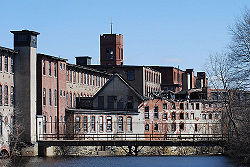
Pontiac, Rhode Island
Encyclopedia

Warwick, Rhode Island
Warwick is a city in Kent County, Rhode Island, United States. It is the second largest city in the state, with a population of 82,672 at the 2010 census. Its mayor has been Scott Avedisian since 2000...
and Cranston, Rhode Island
Cranston, Rhode Island
Cranston, once known as Pawtuxet, is a city in Providence County, Rhode Island, United States. With a population of 80,387 at the 2010 census, it is the third largest city in the state. The center of population of Rhode Island is located in Cranston...
.
History
Native AmericansIndigenous peoples of the Americas
The indigenous peoples of the Americas are the pre-Columbian inhabitants of North and South America, their descendants and other ethnic groups who are identified with those peoples. Indigenous peoples are known in Canada as Aboriginal peoples, and in the United States as Native Americans...
referred to the area as "Papepieset" or "Toskiounke." After arriving in 1642, the early English settlers called the area "Great Weir" because fishing weir
Fishing weir
A fishing weir, or fish weir, is an obstruction placed in tidal waters or wholly or partially across a river, which is designed to hinder the passage of fish. Traditionally they were built from wood or stones. They can be used to trap fish...
s were used to catch fish near the falls. After a bridge was constructed in the locality, the area became known as "the great bridge near the weir," and eventually " Capt. Benjamin Greene's bridge" then "Arnold's bridge." After Senator John Hopkins Clarke
John Hopkins Clarke
John Hopkins Clarke was a United States Senator from Rhode Island. Born in Elizabeth, New Jersey, he moved to Providence where he studied under a private teacher. He graduated from Brown University in 1809, studied law, admitted to the bar and commenced practice in Providence in 1812...
purchased the water rights, the region assumed the name of "Clarksville." After purchasing the area, the Pontiac Manufacturing Company named the area "Pontiac" after Chief Pontiac
Chief Pontiac
Pontiac or Obwandiyag , was an Ottawa leader who became famous for his role in Pontiac's Rebellion , an American Indian struggle against the British military occupation of the Great Lakes region following the British victory in the French and Indian War. Historians disagree about Pontiac's...
a Northwestern Indian chief. Allegedly, "Mr. Clark, while out in Michigan, saw the picture of the old chief, Pontiac, and on his return had it engraved, to be used as a label on his goods. The name gradually became attached to the village after he left, though many continued to call it " Arnold's Bridge." In 1863 Benjamin Knight
Benjamin Knight
Benjamin Knight was a New England industrialist and philanthropist, who was a partner with his brother Robert Knight in the B. B. & R. Knight Company and was one of the largest textile manufacturers in the world when he died in 1898...
and Robert Knight
Robert Knight (industrialist)
Robert Knight was a New England industrialist and philanthropist, who was a partner with his brother Benjamin Knight in B. B. & R. Knight and was one of the largest textile manufacturers in the world when he died in 1912...
, two brothers, built the Pontiac Mills
Pontiac Mills
Pontiac Mills are historic mills on Knight Street in the village of Pontiac, Rhode Island within the town of Warwick, Rhode Island. The mills produced the original Fruit of the Loom brand clothing....
in the village.
See also
- List of Registered Historic Places in Rhode Island
- New York, Providence and Boston RailroadNew York, Providence and Boston RailroadThe New York, Providence and Boston Railroad, normally called the Stonington Line, was a major part of the New York, New Haven and Hartford Railroad between New London, Connecticut and Providence, Rhode Island...
, operated the Pontiac Branch Railroad to the village - Pontiac MillsPontiac MillsPontiac Mills are historic mills on Knight Street in the village of Pontiac, Rhode Island within the town of Warwick, Rhode Island. The mills produced the original Fruit of the Loom brand clothing....
External links
- The history of Warwick, Rhode Island, from its settlement in 1642 to the present time: including accounts of the early settlement and development of its several villages; sketches of the origin and progress of the different churches of the town, &c., &c by Oliver Payson Fuller (Angell, Burlingame & co., printers, 1875)pg. 259 http://books.google.com/books?id=XZQNAQAAIAAJ&source=gbs_navlinks_s

